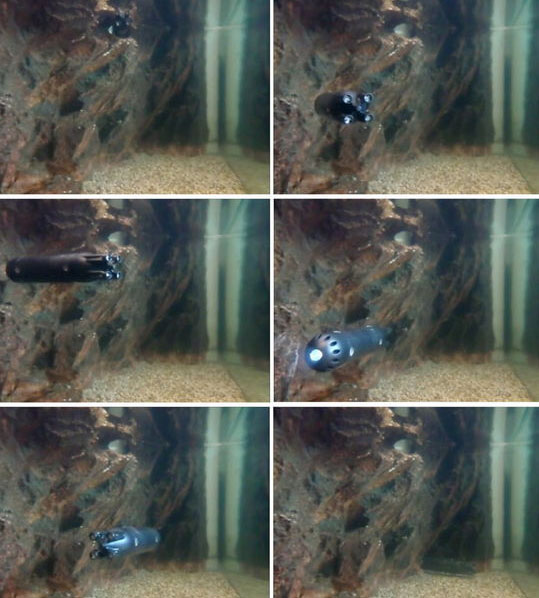Mini submarine explores Jupiter's moon
One of the first 'travelers' to Jupiter's icy satellite planet could be a small submarine about the size of two cans of soft drinks.
>>>Raw materials of life exist on Jupiter satellites
Miniature submarines are the idea of balancing the cost and the ability of a robot to search for extraterrestrial life, specifically here in the oceans below the planet's ice cover Europa - ' The moon 'covered with ice by Jupiter.
This idea originally came from NASA's Jet Propulsion Laboratory (JPL) in California, USA and Uppsala University in Sweden. Such a small device will help reduce the cost of entering space when the cost can be up to tens of thousands of dollars per kilogram. The concept of tasks also becomes more noticeable when just drilling a small hole through the ice covering the surface of Europa.

Photos of experimental activities of mini submarine Dadu
Scientists have been fascinated by the viability of life on Europa since the Voyager 2 mission first discovered the potential of Jupiter's "icy moon" in 1979. Image and data Voyager 2's data shows the existence of an ocean of hidden water under the ice surface of Europa and the water reserves may be larger than all Earth's oceans combined.
The existence of bacteria in the Arctic in harsh ice conditions suggests that life can exist in the freezing of Europa. But any life on Europa will only exist by hiding deep beneath its ice surface. Europa has a covered ice sheet with a surface thickness of up to 3 km, because the radiation from the origin of Jupiter's magnetosphere bombarded its surface.
Such intense radiation causes a robot ship to land, only a few steps into the ice surface of Europa will not find any organic traces or signs of life. Instead, this tiny submarine may be more fortunate by going deeper into the icy shell to study the ocean of Europa.
The small submarine capable of deepening (Dadu) has been tested in a similar environment on Earth in 2012, where its small size can prove particularly useful. It has explored Lake Vostok in Antarctica, which is believed to have been isolated from the rest of the world by the kilometer thickness of ice for millions of years. In the future, it will participate in expedition programs to new frozen planets, typically Europa and Enceladus.
The Dadu will use 8 small thrusters to operate underwater. An optical cable will connect Dadu to a lander on the surface or station to charge the submarine and allow the operator to remotely control it. Software on board will allow the submarine to automatically dodge obstacles or stay under a certain depth of water.

Dadu mini submarine is only 2 cans of soft drinks and has a 'super quest' to explore the ocean deep in the mesh of Europa.
The Swedish team created a series of miniature and sensor tools for this 'miniature submarine dream' . Dadu has a camera in front with a small high-resolution laser camera and can measure the distance, size and shape of underwater objects.
The first prototypes of the Dadu submarine were made of plastic from 3D printers, which allowed the team to quickly "print" digital designs into real objects. But they envision actual submarines built from a titanium alloy to survive in extreme temperatures and intense pressure of underwater environments.
Next, the Swedish research team hopes to refine more miniature tools. They also need to build fully integrated systems with all miniature electronics before they seriously test the submarine's ability to survive an icy ocean - whether on earth or on the planet. on Europa.
The European Space Agency is planning to fulfill Jupiter's "ice moon" in 2030. NASA has also begun planning a mission to explore Europa when it comes to understanding planets. limited to a path of Jupiter.
- Robot submarine explores extraterrestrial oceans
- Truong Sa 02 submarine gradually formed: New ambition!
- Bombard the mini moon to test Earth defenses
- The earth has thousands of moons
- Scientists shocked because NASA stopped producing the only ship to explore the moon
- 17 submarine and one-man submarine surprises you
- Stingray ray submarine
- The moon has 600 million tons of ice
- Two spacecraft about to plunge into the moon to
- The truth about Chinese submarine technology
- NASA returned to the moon
- Submarine K-27 - Soviet
 Van Allen's belt and evidence that the Apollo 11 mission to the Moon was myth
Van Allen's belt and evidence that the Apollo 11 mission to the Moon was myth The levels of civilization in the universe (Kardashev scale)
The levels of civilization in the universe (Kardashev scale) Today Mars, the sun and the Earth are aligned
Today Mars, the sun and the Earth are aligned The Amazon owner announced a secret plan to build a space base for thousands of people
The Amazon owner announced a secret plan to build a space base for thousands of people NASA and SpaceX postpone Europa Clipper launch due to Hurricane Milton
NASA and SpaceX postpone Europa Clipper launch due to Hurricane Milton  'Backbone' of creature discovered on Jupiter's moon
'Backbone' of creature discovered on Jupiter's moon  NASA captured 'Platypus' moving in alien world
NASA captured 'Platypus' moving in alien world  Traces of life in an unexpected place in the middle of the solar system
Traces of life in an unexpected place in the middle of the solar system  NASA's Europa Clipper spacecraft passes a series of important tests
NASA's Europa Clipper spacecraft passes a series of important tests  NASA reveals herd of 'messenger' robots to meet aliens
NASA reveals herd of 'messenger' robots to meet aliens 